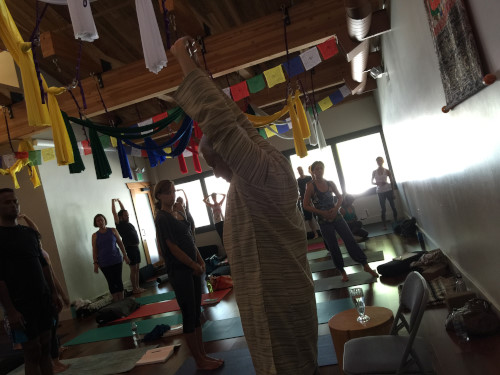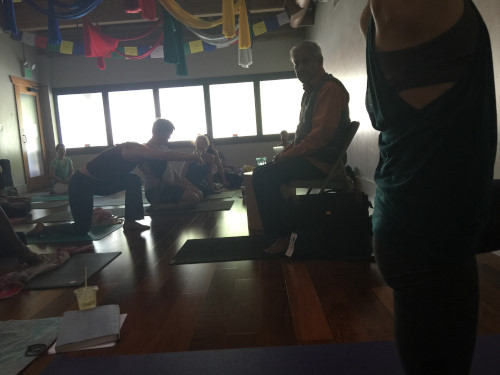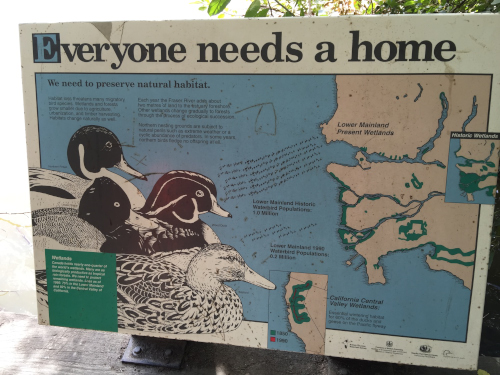Srivatsa Ramaswami* is always at home, wherever he goes:) That was one of the lessons I felt more than all the vinyasa sequences this legendary teacher still teaches with precision. What he learned from studying over 30 years with Sri T Krishnamarcharya – directly, he shares. Awe-inspriring bio. and yet so so very … humble and … fearless. His expectations and intentions are so clear, there’s no room for fear. Very humble at the age of almost 80, it’s inspiring to learn from someone with such deep understanding and experience. I only have a snippet – scratched the surface only … I had to laugh when he’s noted as E-500 hrs. … I mean,it’s so silly – he’s beyond such certification. He’s studied with the master for 33 years; taught for over 20 years – Pleeaase, he’s a category of his own, way beyond. Is there something like 10,000 hours? That’s defined as mastery even though he would be so modest to decline such a title – as it’s obvious to see he’s not teaching out of ego; he’s teaching in service. There’s that same quality we can feel with BK Bose, founder of Niroga, a place I am currently a student of for the study of yoga therapy. What a blessing that teachers do really appear when you are ready:

 Referring back to the video (credit to UpLift – from utube promo) I posted few times here, take the time to watch again and let the significance sink in. It’s a practice of a lifetime you can start any time … to cultivate fearlessness.
Referring back to the video (credit to UpLift – from utube promo) I posted few times here, take the time to watch again and let the significance sink in. It’s a practice of a lifetime you can start any time … to cultivate fearlessness.
And speaking of fear, as seeing that girl with “I love Paris” T-shirt made me think of this interesting illness. It’s called the “Paris Syndrome”.
It’s defined in Wikipedia as:
Paris syndrome (French: Syndrome de Paris, Japanese: パリ症候群, Pari shōkōgun) is a transient mental disorder exhibited by some individuals when visiting or going on vacation to Paris, as a result of extreme shock derived from their discovery that Paris is not what they had expected it to be. The syndrome is characterized by a number of psychiatric symptoms such as acute delusional states, hallucinations, feelings of persecution (perceptions of being a victim of prejudice, aggression, or hostility from others), derealization, depersonalization, anxiety, and also psychosomatic manifestations such as dizziness, tachycardia, sweating, and others, such as vomiting.[1] Similar syndromes include Jerusalem syndrome and Stendhal syndrome. The condition is commonly viewed as a severe form of culture shock. It is particularly noted among Japanese travelers.

When I first heard of this syndrome, I thought it was a joke. But look at ourselves and how we welcome our visitors and immigrants … the “foreigners”, ourselves. And again re-look at visitors, newly arrived immigrants and long-time immigrants – and even Americans who are so-many generations rooted on this land. There’s dis-ease among some and it all comes from the sense of not fully being in their own skin; not fully occupying space, not really feeling at HOME. Then in these spots you dreamed about visiting, there’s this feeling of environments and people not meeting your expectations … that could create stress as extreme as Paris Syndrome I think to many who live here. It’s a place of hope and dreams, this place … but it falls short?
It’s not a full blown out Paris Syndrome but there’s a spectrum, a range to any disorder and I feel many here live in fear, experiencing their own version of culture shock frequently. Over time, there’s that sense of being disconnected within and outside of our body and mind. We need to be connected not only within, but within the community; we need a home away from home so many gather among themselves looking for that familiarity disdainful of differences … in a way, there’s that homesick blues those on green cards and even naturalized citizens experience when there’s a disconnect at whatever level. Here. Wouldn’t it be so American, so human, if everyone was a little more welcoming, a little less fearful, and a little more invested in that sense of community. I felt that when I spent the weekend at Niroga Yoga Therapist Advance Training as we heard incredibly service-oriented presentations of cohorts who are true healers. Then we delved into the issues of chronic pain and persistent pain. Lower back pains, shoulders, knees, headaches, the neck … the list is long – and Pain is real. It’s not imagined. It’s not all in someone’s head. With a huge toolbox we have been given, ultimately, it’s about finding safety within your own home, at the same time, welcoming the homeless with shelter and warmth. To be fully connected inside and out; to be integrated and feeling whole and enough. It’s yoga. It’s home:) Swirling thoughts amidst many homecomings this Thanksgiving week.

*Really enjoyed reading this interview – Thank you so much for sharing.